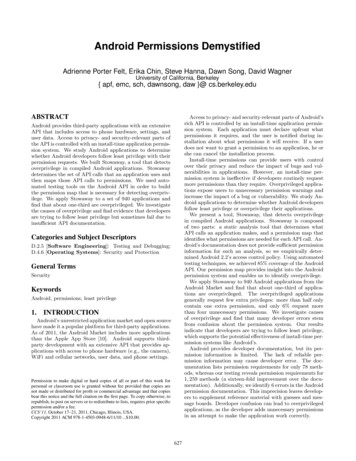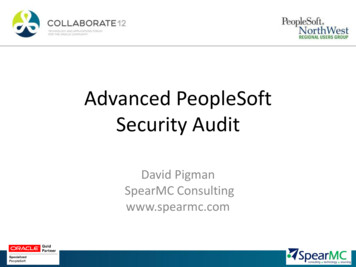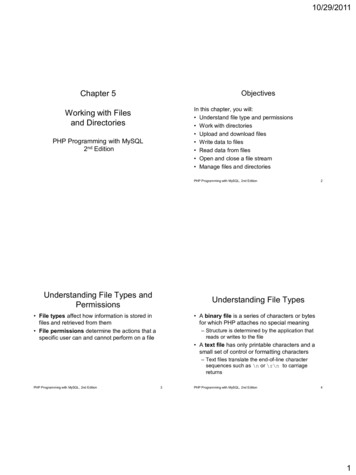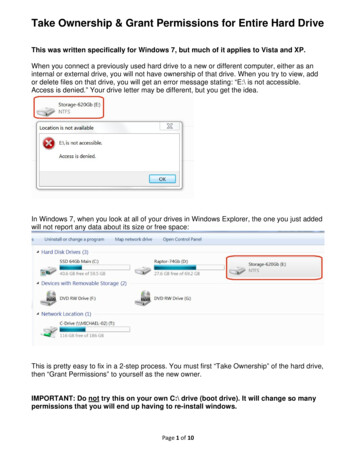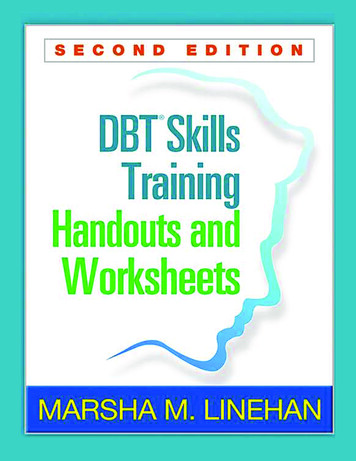
Transcription
2015 Marsha M. LinehanPublished by The Guilford PressA Division of Guilford Publications, Inc.370 Seventh Avenue, Suite 1200, New York, NY 10001www.guilford.comAll rights reservedLIMITED DUPLICATION LICENSEThe publisher grants to individual purchasers of DBT Skills Training Handouts and Worksheets,Second Edition, and DBT Skills Training Manual, Second Edition, nonassignable permission toreproduce these materials. This license is limited to you, the individual purchaser, for personal use oruse with individual clients. This license does not grant the right to reproduce these materials for resale,redistribution, electronic display, or any other purposes (including but not limited to books, pamphlets,articles, video- or audiotapes, blogs, file-sharing sites, Internet or intranet sites, and handouts orslides for lectures, workshops, or webinars, whether or not a fee is charged). Permission to reproducethese materials for these and any other purposes must be obtained in writing from the PermissionsDepartment of Guilford Publications.The author has checked with sources believed to be reliable in her efforts to provide information thatis complete and generally in accord with the standards of practice that are accepted at the time ofpublication. However, in view of the possibility of human error or changes in behavioral, mental health,or medical sciences, neither the author, nor the editor and publisher, nor any other party who has beeninvolved in the preparation or publication of this work warrants that the information contained hereinis in every respect accurate or complete, and they are not responsible for any errors or omissions or theresults obtained from the use of such information. Readers are encouraged to confirm the informationcontained in this document with other sources.DBT is a registered trademark of Marsha M. Linehan.ii
CONTENTSGeneral Skills: Orientation and Analyzing BehaviorGeneral HandoutsOrientation HandoutsGeneral Handout 1: Goals of Skills TrainingGeneral Handout 1a: Options for Solving Any ProblemGeneral Handout 2: Overview—Introduction to Skills TrainingGeneral Handout 3: Guidelines for Skills TrainingGeneral Handout 4: Skills Training AssumptionsGeneral Handout 5: Biosocial TheoryHandouts for Analyzing BehaviorGeneral Handout 6: Overview—Analyzing BehaviorGeneral Handout 7: Chain AnalysisGeneral Handout 7a: Chain Analysis, Step by StepGeneral Handout 8: Missing-Links AnalysisGeneral WorksheetsOrientation WorksheetGeneral Worksheet 1: Pros and Cons of Using SkillsWorksheets for Analyzing BehaviorGeneral Worksheet 2: Chain Analysis of Problem BehaviorGeneral Worksheet 2a: Example—Chain Analysis of Problem BehaviorGeneral Worksheet 3: Missing-Links Analysisiii
General HandoutsOrientation Handouts
General Handout 1(General Worksheet 1 )72.p ;Goals of Skills TrainingGeneral GoalTo learn how to change your own behaviors, emotions, and thoughtsthat are linked to problems in living and are causing misery and distress.Specific GoalsBehaviors to Decrease: Mindlessness; emptiness; being out of touch with self and others; judgmentalness. Interpersonal conflict and stress; loneliness. Absence of flexibility; difficulties with change. Up-and-down and extreme emotions; mood- dependent behavior; difficulties in regulatingemotions. Impulsive behaviors; acting without thinking; difficulties accepting reality as it is; willfulness;addiction.Skills to Increase: Mindfulness skills. Interpersonal effectiveness skills. Emotion regulation skills. Distress tolerance skills.Personal GoalsBehaviors to Decrease:1.2.3.Skills to Increase:1.2.3.From DBT Skills Training Handouts and Worksheets, Second Edition, by Marsha M. Linehan. Copyright 2015 by Marsha M. Linehan. Permission to photocopy this handout is granted to purchasers of DBT Skills Training Handouts and Worksheets, Second Edition, and DBT SkillsTraining Manual, Second Edition, for personal use and use with individual clients only. (See page ii of this packet for details.)
General Handout 1a Options for Solving Any ProblemWhen life presents you with problems, what are your options?1. Solve the ProblemChange the situation . . . or avoid, leave, or get out of the situation for good.2. Feel Better about the ProblemChange (or regulate) your emotional response to the problem.3. Tolerate the ProblemAccept and tolerate both the problem and your response to the problem.4. Stay MiserableOr possibly make it worse!1. To Problem-Solve:Use interpersonal effectiveness skillsWalking the Middle Path (from interpersonal effectiveness skills)Use problem- solving skills (from emotion regulation skills)2. To Feel Better about the Problem:Use emotion regulation skills3. To Tolerate the Problem:Use distress tolerance and mindfulness skills4. To Stay Miserable:Use no skills!From DBT Skills Training Handouts and Worksheets, Second Edition, by Marsha M. Linehan. Copyright 2015 by Marsha M. Linehan. Permission to photocopy this handout is granted to purchasers of DBT Skills Training Handouts and Worksheets, Second Edition, and DBT SkillsTraining Manual, Second Edition, for personal use and use with individual clients only. (See page ii of this packet for details.)
General Handout 2Overview:Introduction to Skills TrainingGuidelines for Skills TrainingSkills Training AssumptionsBiosocial Theoryof Emotional andBehavioral DysregulationFrom DBT Skills Training Handouts and Worksheets, Second Edition, by Marsha M. Linehan. Copyright 2015 by Marsha M. Linehan. Permission to photocopy this handout is granted to purchasers of DBT Skills Training Handouts and Worksheets, Second Edition, and DBT SkillsTraining Manual, Second Edition, for personal use and use with individual clients only. (See page ii of this packet for details.)
General Handout 3 Guidelines for Skills Training1. Participants who drop out of skills training are not out of skills training.a. The only way out is to miss four scheduled sessions of skills training in a row.2. Participants who join the skills training group support each other and:a.b.c.d.e.f.Keep names of other participants and information obtained during sessions confidential.Come to each group session on time and stay until the end.Make every effort to practice skills between sessions.Validate each other, avoid judging each other, and assume the best about each other.Give helpful, noncritical feedback when asked.Are willing to accept help from a person they ask or call for help.3. Participants who join the skills training group:a. Call ahead of time if they are going to be late or miss a session.4. Participants do not tempt others to engage in problem behaviors and:a. Do not come to sessions under the influence of drugs or alcohol.b. If drugs or alcohol have already been used, come to sessions acting and appearing cleanand sober.c. Do not discuss, inside or outside sessions, current or past problem behaviors that could becontagious to others.5. Participants do not form confidential relationships with each other outside of skillstraining sessions and:a. Do not start a sexual or a private relationship that cannot be discussed in group.b. Are not partners in risky behaviors, crime, or drug use.Other guidelines for this group/notes:From DBT Skills Training Handouts and Worksheets, Second Edition, by Marsha M. Linehan. Copyright 2015 by Marsha M. Linehan. Permission to photocopy this handout is granted to purchasers of DBT Skills Training Handouts and Worksheets, Second Edition, and DBT SkillsTraining Manual, Second Edition, for personal use and use with individual clients only. (See page ii of this packet for details.)
General Handout 4 Skills Training AssumptionsAn assumption is a belief that cannot be proved,but we agree to abide by it anyway.1. People are doing the best they can.All people at any given point in time are doing the best they can.2. People want to improve.The common characteristic of all people is that they want to improve their lives and be happy.3. People need to do better, try harder, and be more motivated to change.*The fact that people are doing the best they can, and want to do even better, does not meanthat these things are enough to solve the problem.4. People may not have caused all of our own problems, but they have to solve themanyway.**People have to change their own behavioral responses and alter their environment for their lifeto change.5. New behavior has to be learned in all relevant contexts.New behavioral skills have to be practiced in the situations where the skills are needed, not justin the situation where the skills are first learned.6. All behaviors (actions, thoughts, emotions) are caused.There is always a cause or set of causes for our actions, thoughts, and emotions, even if we donot know what the causes are.7. Figuring out and changing the causes of behavior work better than judging and blaming.Judging and blaming are easier, but if we want to create change in the world, we have tochange the chains of events that cause unwanted behaviors and events.*But trying harder and being more motivated may not be needed if progress is steady and at a realistic rate of improvement.**Parents and caregivers must assist children in this task.From DBT Skills Training Handouts and Worksheets, Second Edition, by Marsha M. Linehan. Copyright 2015 by Marsha M. Linehan. Permission to photocopy this handout is granted to purchasers of DBT Skills Training Handouts and Worksheets, Second Edition, and DBT SkillsTraining Manual, Second Edition, for personal use and use with individual clients only. (See page ii of this packet for details.)
General Handout 5(p. 1 of 2)Biosocial TheoryWhy do I have so much trouble controllingmy emotions and my actions?Emotional vulnerability is biological:It’s simply how some people are born. They are more sensitive to emotional stimuli; they can detect subtleemotional information in the environment that others don’t even notice. They experience emotions much more often than others. Their emotions seem to hit for no reason, from out of the blue. They have more intense emotions. Their emotions hit like a ton of bricks. And their emotions are long- lasting.Impulsivity also has a biological basis:Regulating action is harder for some than for others. They find it very hard to restrain impulsive behaviors. Often, without thinking, they do things that get them in trouble. Sometimes their behavior seems to come out of nowhere. They find it very hard to be effective. Their moods get in the way of organizing to achieve their goals. They cannot control behaviors linked to their moods.(continued on next page)From DBT Skills Training Handouts and Worksheets, Second Edition, by Marsha M. Linehan. Copyright 2015 by Marsha M. Linehan. Permission to photocopy this handout is granted to purchasers of DBT Skills Training Handouts and Worksheets, Second Edition, and DBT SkillsTraining Manual, Second Edition, for personal use and use with individual clients only. (See page ii of this packet for details.)
General Handout 5(p. 2 of 2)An invalidating social environmentcan make it very hard to regulate emotions. An invalidating environment doesn’t seem to understand your emotions. It tells you your emotions are invalid, weird, wrong, or bad. It often ignores your emotional reactions and does nothing to help you. It may say things like “Don’t be such a baby!” “Quit your blubbering.” “Quitbeing such a chicken and just solve the problem.” or “Normal people don’tget this frustrated.” People who invalidate are often doing the best they can. They may not know how to validate or how important it is to validate, orthey may be afraid that if they validate your emotions, you will get moreemotional, not less. They may be under high stress or time pressure, or they may have toofew resources themselves. There may be just a poor fit between you and your social environment:You may be a tulip in a rose garden.An ineffective social environmentis a big problem when you wantto learn to regulate emotions and actions. Your environment may reinforce out-of- control emotions and actions. If people give in when you get out of control, it will be hard for you to get incontrol. If others command you to change, but don’t coach you on how to do this,it will be hard to keep on trying to change.It’s the transactions that countbetween the person and the social environment. Biology and the social environment influence the person. The person reciprocates and influences his or her social environment. The social environment reciprocates and influences the person. And so on and on and on.
Handouts for Analyzing Behavior
General Handout 6(General Worksheets 2, 3 )83, 13. pp;Overview:Analyzing BehaviorTo figure out its causesand plan for problem solving.Chain Analysisis for when you engage in ineffective behavior.A chain analysis examines the chain of events that leads toineffective behaviors, as well as the consequences of thosebehaviors that may be making it hard to change them. It alsohelps you figure out how to repair the damage.Missing-Links Analysisis for when you fail to engage in effective behaviors.A missing-links analysis helps you identify what got in the way ofdoing things you needed or hoped to do, things you agreed to do,or things others expected you to do. It also helps you problemsolve for the future.From DBT Skills Training Handouts and Worksheets, Second Edition, by Marsha M. Linehan. Copyright 2015 by Marsha M. Linehan. Permission to photocopy this handout is granted to purchasers of DBT Skills Training Handouts and Worksheets, Second Edition, and DBT SkillsTraining Manual, Second Edition, for personal use and use with individual clients only. (See page ii of this packet for details.)
General Handout 7(General Worksheets 2, 2a )53, 13. pp;Chain AnalysisTo understand behavior, do a chain analysis.PROBLEM BEHAVIORVULNERABILITYPROMPTING EVENTLINKSCONSEQUENCESStep 1: Describe the problem behavior.Step 2: Describe the prompting event that started the chain of events leading to the problembehavior.Step 3: Describe the factors happening before the event that made you vulnerable to startingdown the chain of events toward the problem behavior.Step 4: Describe in excruciating detail the chain of events that led to the problem behavior.Step 5: Describe the consequences of the problem behavior.To change behavior:Step 6: Describe skillful behaviors to replace problem links in the chain of events.Step 7: Develop prevention plans to reduce vulnerability to stressful events.Step 8: Repair important or significant consequences of the problem behavior.From DBT Skills Training Handouts and Worksheets, Second Edition, by Marsha M. Linehan. Copyright 2015 by Marsha M. Linehan. Permission to photocopy this handout is granted to purchasers of DBT Skills Training Handouts and Worksheets, Second Edition, and DBT SkillsTraining Manual, Second Edition, for personal use and use with individual clients only. (See page ii of this packet for details.)
General Handout 7a(p. 1 of 2)(General Worksheets 2, 2a )53, 13. pp;Chain Analysis, Step by Step1. Describe the specific problem behavior (overeating or overdrinking, yelling at yourkids, throwing a chair, having an overwhelming emotional outburst, dissociating, not coming orcoming late to skills training, putting off or refusing to do skills practice, etc.).A. Be very specific and detailed. No vague terms.B. Identify exactly what you did, said, thought, or felt (if feelings are the targeted problembehavior). Identify what you did not do.C. Describe the intensity of the behavior and other characteristics of the behavior that areimportant.D. Describe the problem behavior in enough detail that an actor in a play or movie couldrecreate the behavior exactly.E. If the behavior is something you did not do, ask yourself whether (a) you did not know youneeded to do it (it did not get into short-term memory); (b) you forgot it and later it nevercame into your mind to do it (it did not get into long-term memory); (c) you put it off whenyou did think of it; (d) you refused to do it when you thought of it; or (e) you were willful andrejected doing it, or some other behavior, thoughts, or emotions interfered with doing it. If (a)or (b) is the case, skip from here to Step 6 below (working on solutions). Otherwise, keepgoing from here.2. Describe the specific prompting event that started the whole chain of behavior. Beginwith the environmental event that started the chain. Always begin with some event in yourenvironment, even if it doesn’t seem to you that the environmental event “caused” the problembehavior. Otherwise, we could ask about any behavior, thought, feeling, or experience, “Whatprompted that?” Possible questions to help you get at this are:A. What exact event precipitated the start of the chain reaction?B. When did the sequence of events that led to the problem behavior begin? When did theproblem start?C. What was going on right before the thought of or impulse for the problem behavior occurred?D. What were you doing/thinking/feeling/imagining at that time?E. Why did the problem behavior happen on that day instead of the day before?3. Describe specific vulnerability factors happening before the prompting event.What factors or events made you more vulnerable to reacting to the prompting event with aproblematic chain? Areas to examine are:A. Physical illness; unbalanced eating or sleeping; injury.B. Use of drugs or alcohol; misuse of prescription drugs.C. Stressful events in the environment (either positive or negative).D. Intense emotions, such as sadness, anger, fear, loneliness.E. Previous behaviors of your own that you found stressful coming into your mind.(continued on next page)From DBT Skills Training Handouts and Worksheets, Second Edition, by Marsha M. Linehan. Copyright 2015 by Marsha M. Linehan. Permission to photocopy this handout is granted to purchasers of DBT Skills Training Handouts and Worksheets, Second Edition, and DBT SkillsTraining Manual, Second Edition, for personal use and use with individual clients only. (See page ii of this packet for details.)
General Handout 7a(p. 2 of 2)4. Describe in excruciating detail the chain of events that led to the problem behavior.Imagine that your problem behavior is chained to the precipitating event in the environment.How long is the chain? Where does it go? What are the links? Write out all links in the chain ofevents, no matter how small. Be very specific, as if you are writing a script for a play. Links inthe chain can be:A. Actions or things you do.B. Body sensations or feelings.C. Cognitions (i.e., beliefs, expectations, or thoughts).D. Events in the environment or things others do.E. Feelings and emotions that you experience.What exact thought (or belief), feeling, or action followed the prompting event? What thought,feeling, or action followed that? What next? What next? And so forth. Look at each link in the chain after you write it. Was there another thought, feeling, or actionthat could have occurred? Could someone else have thought, felt, or acted differently at thatpoint? If so, explain how that specific thought, feeling, or action came to be. For each link in the chain, ask whether there is a smaller link you could describe.5. Describe the consequences of this behavior. Be specific. (How did other people reactimmediately and later? How did you feel immediately following the behavior? Later? What effectdid the behavior have on you and your environment?)6. Describe in detail at each point where you could have used a skillful behavior to head off theproblem behavior. What key links were most important in leading to the problem behavior? (Inother words, if you had eliminated these behaviors, the problem behavior probably would nothave happened.)A. Go back to the chain of behaviors following the prompting event. Circle each link where, ifyou had done something different, you would have avoided the problem behavior.B. What could you have done differently at each link in the chain of events to avoid the problembehavior? What coping behaviors or skillful behaviors could you have used?7. Describe in detail a prevention strategy for how you could have kept the chain fromstarting by reducing your vulnerability to the chain.8. Describe what you are going to do to repair important or significant consequences of theproblem behavior.A. Analyze: What did you really harm? What was the negative consequence you can repair?B. Look at the harm or distress you actually caused others, and the harm or distress youcaused yourself. Repair what you damaged. (Don’t bring flowers to repair a window youbroke: fix the window! Repair a betrayal of trust by being very trustworthy long enough to fitthe betrayal, rather than trying to fix it with love letters and constant apologies. Repair failureby succeeding, not by berating yourself.)
General Handout 8(General Worksheet 3 )83.p;Missing-Links AnalysisAsk the following questions to understand how and whyeffective behavior that is needed or expected did not occur.1. Did you know what effective behavior was needed or expected (what skillshomework was given, what skills to use, etc.)?If no to Question 1, ask what got in the way of knowing what was needed or expected.Ideas might include not paying attention, unclear instructions, never getting the instructionsin the first place, becoming too overwhelmed and couldn’t process the information, and soon.Problem-solve what got in the way. For example, you might work on payingattention, ask for clarification when you don’t understand instructions, call others, lookup information, and so on.2. If yes to Question 1, ask were you willing to do the needed or expected effectivebehavior?If no to Question 2, ask what got in the way of willingness to do effective behaviors.Ideas might include willfulness, feeling inadequate, or feeling demoralized.Problem-solve what got in the way of willingness. For example, you might practiceradical acceptance, do pros and cons, practice opposite action, and so on.3. If yes to Question 2, ask did the thought of doing the needed or expected effectivebehavior ever enter your mind?If no to Question 3,Problem-solve how to get the thought of doing effective behaviors into your mind.For example, you might put it on your calendar, set your alarm to go off, put your skillsnotebook next to your bed, practice coping ahead with difficult situations (see EmotionRegulation Handout 19), and so on.4. If yes to Question 3, ask what got in the way of doing the needed or expectedeffective behavior right away? Ideas might include putting it off, continuing toprocrastinate, not being in the mood, forgetting how to do what was needed, thinking thatno one would care anyway (or no one would find out), and so on.Problem-solve what got in the way. For example, you might set a reward for doingwhat is expected, practice opposite action, do pros and cons, and so on.From DBT Skills Training Handouts and Worksheets, Second Edition, by Marsha M. Linehan. Copyright 2015 by Marsha M. Linehan. Permission to photocopy this handout is granted to purchasers of DBT Skills Training Handouts and Worksheets, Second Edition, and DBT SkillsTraining Manual, Second Edition, for personal use and use with individual clients only. (See page ii of this packet for details.)
General WorksheetsOrientation Worksheet
General Worksheet 1(General Handout 1 )9.p;Pros and Cons of Using SkillsDue Date: Name: Week Starting:Use this worksheet to figure out the advantages and disadvantages to you of using skills (i.e., actingskillfully) to reach your goals. The idea here is to figure out what is the most effective way for you toget what you want in life. Remember, this is about your goals, not someone else’s goals.Describe the situation or problem:Describe your goal in this situation:Make a list of the Pros and Cons of practicing your skills in this situation.Make another list of the Pros and Cons for not practicing your skills or of not practicing themcompletely.Check the facts to be sure that you are correct in your assessment of advantages anddisadvantages.ConsProsWrite on the back if you need more space.Practicing SkillsNot Practicing SkillsPracticing SkillsNot Practicing SkillsWhat did you decide to do in this situation?Is this the best decision (in Wise Mind)?From DBT Skills Training Handouts and Worksheets, Second Edition, by Marsha M. Linehan. Copyright 2015 by Marsha M. Linehan. Permission to photocopy this worksheet is granted to purchasers of DBT Skills Training Handouts and Worksheets, Second Edition, and DBT SkillsTraining Manual, Second Edition, for personal use and use with individual clients only. (See page ii of this packet for details.)
Worksheets for Analyzing Behavior
General Worksheet 2(p. 1 of 4)(General Handouts 7, 7a )12–02. pp;Chain Analysis of Problem BehaviorDue Date: Name: � Date:PROBLEM BEHAVIORVULNERABILITYPROMPTING EVENTLINKSCONSEQUENCES1. What exactly is the major problem behavior that I am analyzing?2. What prompting event in the environment started me on the chain to my problembehavior? Include what happened right before the urge or thought came into mymind.Day prompting event occurred:3. Describe what things in myself and in my environment made me vulnerable.Day the events making me vulnerable started:(continued on next page)From DBT Skills Training Handouts and Worksheets, Second Edition, by Marsha M. Linehan. Copyright 2015 by Marsha M. Linehan. Permission to photocopy this worksheet is granted to purchasers of DBT Skills Training Handouts and Worksheets, Second Edition, and DBT SkillsTraining Manual, Second Edition, for personal use and use with individual clients only. (See page ii of this packet for details.)
General Worksheet 2(p. 2 of 4)Links in the chain of events: Behaviors (Actions, Body sensations,Cognitions/Thoughts, Feelings) and Events (in the environment)Possible Types of LinksA. ActionsB. Body sensationsC. Cognitions/thoughtsE. EventsF. Feelings4. List the chain of events (specificbehaviors and environmental events thatactually did happen). Use the ABC-EF listabove.6. List new, more skillful behaviors toreplace ineffective behaviors. Use theABC-EF th.7th.7th.8th.8th.9th.9th.(continued on next page)
General Worksheet 2(p. 3 of 4)Links in the chain of events: Behaviors (Actions, Body sensations,Cognitions/Thoughts, Feelings) and Events (in the environment)Possible Types of LinksA. ActionsB. Body sensationsC. Cognitions/thoughtsE. EventsF. Feelings4. List the chain of events (specificbehaviors and environmental events thatactually did happen). Use the ABC-EF listabove.6. List new, more skillful behaviors toreplace ineffective behaviors. Use theABC-EF 14th.15th.15th.16th.16th.17th.17th.(continued on next page)
General Worksheet 2(p. 4 of 4)5. What exactly were the consequences in the environment?And in myself?What harm did my problem behavior cause?7. Prevention plans:Ways to reduce my vulnerability in the future:Ways to prevent precipitating event from happening again:8. Plans to repair, correct, and overcorrect the harm:
General Worksheet 2a(p. 1 of 3)(General Handouts 7, 7a )12–02. pp;Example: Chain Analysis of Problem BehaviorDue Date: Name: � Date:Problem Behavior:PROBLEM BEHAVIORVULNERABILITYPROMPTING EVENTLINKSCONSEQUENCES1. What exactly is the major problem behavior that I am analyzing?Drinking too much and driving drunk2. What prompting event in the environment started me on the chain to my problembehavior? Include what happened right before the urge or thought came into mymind.Day prompting event occurred: MondayMy sister from out of town called me and said she was not going to come visit me the nextweek like she had said she would, because her husband had an important business partyhe wanted her to attend with him.3. Describe what things in myself and in my environment made me vulnerable.Day the events making me vulnerable started: SundayMy boyfriend said he had to take a business trip sometime in the next month.(continued on next page)From DBT Skills Training Handouts and Worksheets, Second Edition, by Marsha M. Linehan. Copyright 2015 by Marsha M. Linehan. Permission to photocopy this worksheet is granted to purchasers of DBT Skills Training Handouts and Worksheets, Second Edition, and DBT SkillsTraining Manual, Second Edition, for personal use and use with individual clients only. (See page ii of this packet for details.)
General Worksheet 2A (p. 2 of 3)Links in the chain of events: Behaviors (Actions, Body sensations,Cognitions/Thoughts, Feelings) and Events (in the environment)Possible Types of LinksA. ActionsB. Body sensationsC. Cognitions/thoughtsE. EventsF. Feelings4. List the chain of events (specificbehaviors and environmental events thatactually did happen). Use the ABC-EF listabove.6. List new, more skillful behaviors toreplace ineffective behaviors. Use theABC-EF list.1st. I felt hurt and started sobbing on thephone with my sister and was angry withher.1st. Listen to why my sister could notcome.2nd. I thought, “I can’t stand it. No oneloves me.”3rd. I felt very ashamed once I hung upfrom talking to my sister.2nd. Remember that my sister and myboyfriend love me.3rd. Check the facts; is my sister going toreject me over this?4th. I thought “My life is useless; no onewill ever be here for me.”4th. Call my sister back and apologize forbeing angry (since I know she will validatehow I feel).5th. Tried watching TV, but nothing was onI liked.5th. Download a movie, work on a puzzle,or call a friend instead.6th. I started feeling agitated and thought,“I can’t stand this.”6th. Try my TIP skills to bring down arousal.7th. I decided to drink a glass of wine tofeel better, but e
general Worksheet 2: chain analysis of Problem Behavior general Worksheet 2a: example—chain analysis of Problem Behavior general Worksheet 3: Missing-links analysis iii CONTENTS. geral Handoutsen Orientation Handouts. fom DBT kills Training Handouts and Worksheets, econd Editi

